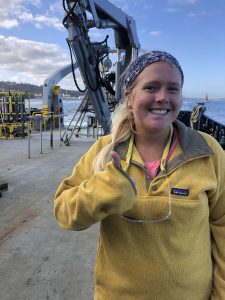Hometown: Atlanta, GA
Lab: Prairie Lab in the Environmental and Ocean Sciences Department at the University of San Diego
Lab website: http://home.sandiego.edu/~jcprairie/
Hobbies: Surfing, hiking, painting, reading, and gardening
What do you study? I study the stickiness of phytoplankton using 3D images. When phytoplankton run into each other in the ocean, they can sometimes stick together in big clumps called marine snow, which then sink to the bottom of the ocean. I look at how often these phytoplankton cells stick together when they run into each other.
Why is it important? This research is important because phytoplankton are an important part of the carbon cycle! They create half of the oxygen we breathe, and when they stick together and sink they bring carbon into the deep ocean, which helps mitigate climate change. Understanding how sticky they are will help us make better predictions about how much carbon they are taking out of the atmosphere.
How did you become interested in science? I grew up part-time on the beaches in North Florida and was always fascinated by shark teeth. I wanted to know more about the sharks, and the ocean where they lived, so I decided to study marine science.
What do you like about being a scientist? My favorite part about being a scientist is getting to work with other scientists to solve problems that no one has solved before. Not only do I get to study really cool information, but I also get to help the world understand what phytoplankton is and why it is important with my research.
What are 5 general vocabulary terms someone should know going into your field of science?
Phytoplankton, 3D, currents, collisions, aggregation
What are 5 specific vocabulary terms someone should know about your research?
Stereoscopy, particle tracking velocimetry (PTV), the biological pump, carbon export

